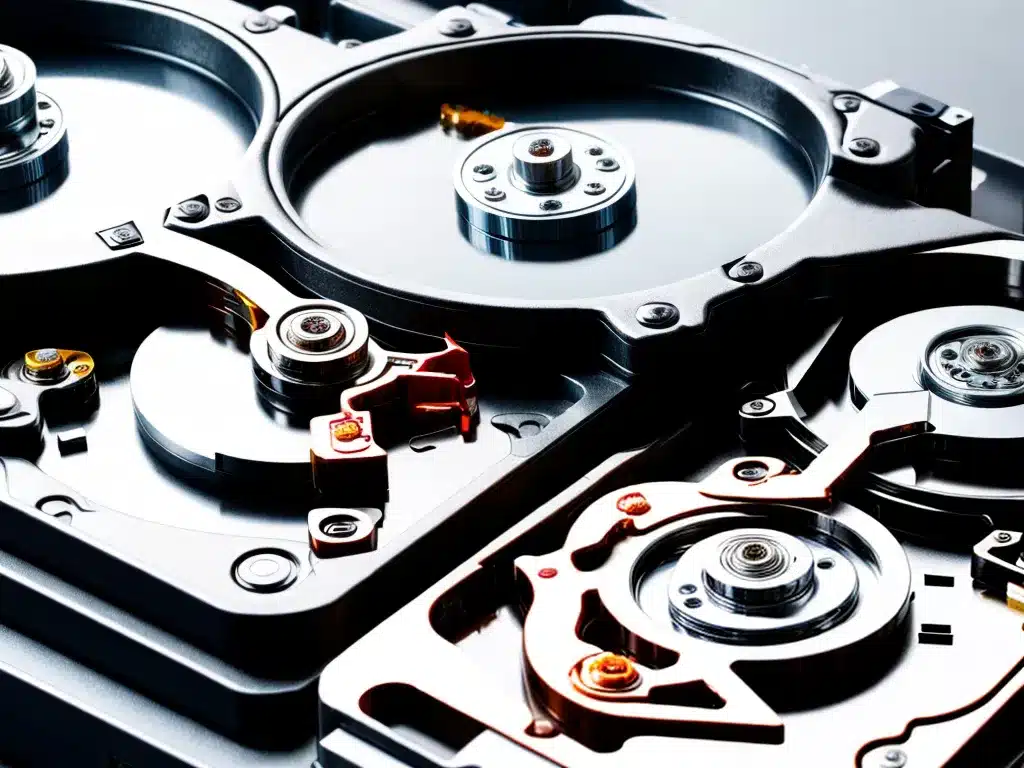Recovering data from a hard drive that won’t boot up or respond can seem daunting, but advances in data recovery technology have made it possible to salvage data from even severely damaged drives. As we enter 2024, here is an overview of the current state of hard drive data recovery and what options are available for recovering data from dead hard drives.
What Causes Hard Drives To Fail?
There are several common causes of hard drive failure that can result in the drive not booting up or responding:
Physical Damage
Physical damage from impacts, drops, flood/water damage, or other trauma can damage the platters, heads, motor or electronic components. This can prevent the drive from spinning up or accessing data.
Logical Errors
Logical errors in the file system or directory damage can corrupt the drive and make data inaccessible. This can happen from sudden power loss, virus/malware infection, OS issues, etc.
Mechanical Failure
Mechanical failure of motors, bearings, heads or other internal parts can occur over time and prevent the drive from operating. This is the most common cause of failure in older drives.
Electronic Circuitry Failure
The electronic printed circuit boards (PCBs) can also fail due to components wearing out over time. This can prevent proper operation even if the mechanical parts are intact.
Can Data Be Recovered From Any Failed Hard Drive?
While data recovery is possible from many failed drives, there are certain situations where recovering data may be difficult or impossible:
-
Severe physical damage – Major platters damage, shattered drive, fire/water damage etc. This usually prevents access to data.
-
Failed or degraded drive components – Damaged/seized spindle motor, failed/damaged read/write heads etc. makes data extraction difficult.
-
Completely dead drive – No spin, lights or noise. Indicates electronic failure and specialized tools needed.
-
Encrypted drives – Encryption adds an extra layer of complexity for data recovery. The encryption key is needed for meaningful data.
So while not every drive can be recovered, the majority of failures like logical errors, minor physical damage and mechanical failure can be addressed by DIY or professional data recovery methods.
DIY Hard Drive Data Recovery Methods
There are some DIY data recovery methods you can try before seeking professional help:
Using Data Recovery Software
Many data recovery software like Stellar Data Recovery, EaseUS, Disk Drill etc. can recover deleted files or data from formatted, corrupted, or damaged drives. This works for logical recoverable failures.
Connecting The Drive To Another Computer
You can connect the failed drive to another working computer as a secondary drive and try copying data to the new PC. This may work if the drive is still accessible. External enclosures (SATA-USB) facilitate connecting internal drives to other PCs.
Using Advanced Tools (DDrescue, Photorec etc.)
Tools like DDrescue, Photorec allow you to image failing drives sector-by-sector and extract data from these images. Helpful for mechanical failures.
Check Drive’s PCB and Components
If drive won’t spin up, swapping its PCB with a matching donor drive’s PCB can help isolate electronics issues. Likewise, some component-level soldering repairs may fix certain electronic failures.
These DIY methods can recover data non-operational or clicking drives. But for catastrophic failures, it is better to avoid further damage and approach a professional.
Professional Data Recovery Service Options
For drives with severe physical/mechanical damage or complex logical corruption that require specialized tools and environments, professional data recovery services are recommended.
Local Data Recovery Specialists
Reputable local data recovery companies with class 100 clean room facilities can disassemble drives and perform specialized component-level repairs to recover data. They also have advanced tools and expertise.
Mail-In Data Recovery Services
Nationwide mail-in data recovery services like DriveSavers, Gillware etc. allow you to mail your failed drive to their labs for recovery. This is convenient, fast and more affordable than in-lab services.
Manufacturer Data Recovery Partners
Major hard drive manufacturers like Seagate, WD etc. have authorized data recovery partners who can offer high success rates for their brand of drives. This optimizes recoverability.
Remote Data Recovery
Some providers like Flobo also offer remote data recovery by replicating drive data over internet to their labs, avoiding drive shipping.
So in summary, while no option is 100% guaranteed, professional services offer the best chance of recovering data from a significantly failed or dead hard drive if DIY methods are unsuccessful. As methods improve, more drives can be recovered by 2024.
Can Important Data Be Recovered Affordably?
-
DIY software recovery options are very affordable but suitable only for minor logical failures.
-
Local specialist labs offer moderate pricing but higher success rates for physical and logical failures. Clean room access allows specialized component repairs.
-
Mail-in and remote recovery services balance affordability and capabilities, making them ideal for individual consumers and SMBs. Most important data can be recovered successfully at reasonable costs.
-
Manufacturer partners offer high success rates but are often the most expensive options. Large enterprises often use these services.
So for individual users, mail-in and remote services currently offer the best balance of price and capabilities for recovering important data from dead drives in 2024. With the right provider, most critical data can be recovered at affordable costs. But it is still important to continuously back up important data to avoid reliance on recovery.
Conclusion
While a dead drive situation may seem hopeless, recovering important data is very possible with the right approach. Logical failures are often recoverable via DIY software. More serious physical and mechanical failures require professional assistance. Mail-in services offer a relatively affordable middle ground for most users. With improvements in professional tools and techniques, recovering data from even severely damaged drives may become more achievable by 2024. But continuous backups are always recommended for important data.













